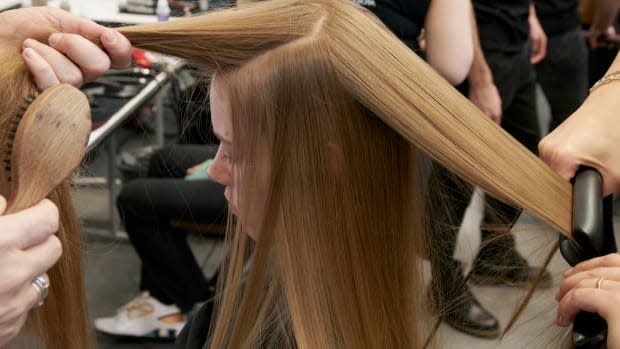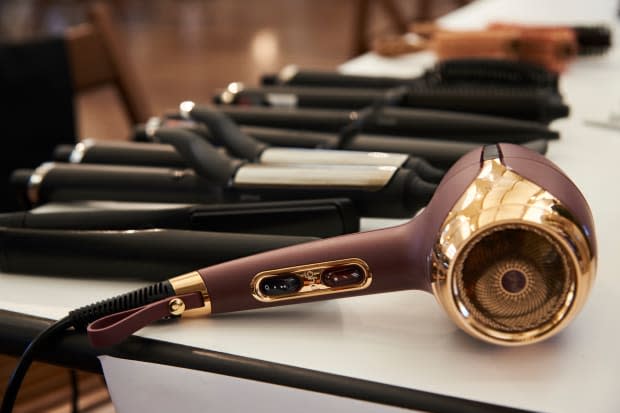Fashionista Beauty Helpline: Do I Really Need to Clean My Hair Tools?
And if so, how often? How do I do it? When do I just replace them? So. Many. Questions.

Photo: Imaxtree
Beauty editors and writers are used to getting late-night (or early-morning, or literally 24-hours-a-day) texts with zero context and burning questions. No, we don't mean of the "U up?" variety. These inquiries are about skin freak-outs, product recommendations and makeup mishaps... and we've seen 'em all. With that in mind, we welcome you to our series, "Fashionista Beauty Helpline," where we address the beauty questions we get asked most frequently — and run them by experts who really know their stuff.
We've all heard experts stress the importance of regularly cleaning your makeup brushes to keep them (and your own general hygiene) in top working shape — but what about hair tools? Many of us rely on brushes, combs, blow-dryers and even hot tools like curling irons and flatirons every single day and hang on to them for years. With all of that use, they're bound to get a little gunk-y and gross; product buildup, dead skin cells from the scalp and shedded strands can create plenty of issues. So how are we supposed to deal?
Once we started thinking about this subject, we began to spiral into plenty of other questions: How often do these tools they really need to be cleaned? What steps and techniques are involved? Do I need special cleansers or cleaning tools? And finally, how do I know when a well-worn hair brush or flatiron becomes a lost cause that needs to be replaced rather than just spruced? We turned to two experts — pro hairstylists Bridget Brager (a T3 ambassador) and Tiffany McRae (an Amika Pro Educator) — for clarity.
"Due to Covid and sanitary precautions being at an all-time high, people are more alert and aware of cleanliness," McRae tells Fashionista, when asked why she thinks this subject is becoming buzzy in the beauty realm right now. "I think the confusion is coming from how contamination happens, what is a 'clean' tool and what's not."
Brager agrees that lifestyle changes — and beauty routine changes — during the pandemic are a contributing factor here. "I think we've all invested in new tools and have been experimenting with fun new ways to up our beauty game since the beginning of Covid, and it makes sense to me now we might be seeing the need to care for them like never before," she says.
The reality is, neglecting to properly clean your hair tools can have some real downsides: "The risk of not cleaning your tools regularly is that it can damage your hair severely," explains Brager. "In the long run, to keep your hair in the best shape possible your tools have to work at peak performance. The only way they can do that is if you are caring for and maintaining them."
Ahead, find these experts' tips for cleaning and maintaining all your hair tools — then go forth and create some of your most impressive at-home hairstyles yet.
How important is it to be cleaning hair tools regularly?
TM: "Cleaning tools regularly is important because you can be confident that residue from the tools isn't being added back to the hair. This prevents disrupting the expected end results, as tools that are not cleaned regularly can make the tools less effective.
The reality is, each time you use a tool it's no longer clean. However it is up to you to decide to clean it based on that fact or from visible residue. If it's based on the fact that when you use your tool, it's no longer clean, you can clean your hair tool after each use. However, if you prefer to clean it based on the visual with product buildup, cleaning can be based on when you see a certain amount of residue."
How often do different types of hair tools need to be cleaned?
TM: "How often you clean a tool is based on how often you use it. If you use your blow dryer daily, and you're the only one using it, monthly maintenance is fine."
BB: "All in all, aim to cleanse your tools and brushes every one to three weeks for best styling results. The more you use them, the more you might have to clean them.
For blow-dryer vents, any time you see lint or grime build up, you should be sure to clean it off for best performance."
How do I clean my blow-dryer?
BB: "If your vent pops off with ease, soak it in hot water with dawn dish soap or a clarifying shampoo and give it a scrub with a tooth brush. If I'm on the go, I like to use a tooth brush and a Lysol wipe."
TM: "Open the filter case and use a blow dryer filter brush to remove dust. If you use your blow dryer once a day, I recommend cleaning your dryer's vent and filter once a month. A blow dryer's filter is protected by a vent that you will need to unlock to get access to the filter. Based on the brand, look at their directions on how best to clean your individual dryer."
How do I properly clean a hair brush? Are there different methods for cleaning a bristled brush versus a plastic brush?
BB: "For synthetic brushes and combs, you should clean [them] once every two weeks, depending on product usage or amount of dry skin build up. If you see buildup, that's your sign to clean them for best usage. Always remove hair after each use of any brush or comb to prevent knots and tangles.
For boar- or natural-bristled brushes, I suggest [cleaning them] once every week, depending on product usage, dandruff or dry skin build up — clean it at the first sight of any of these.
If you have a brush with a wooden handle, fill up a cup with your cleaning solution and dip the head of the brush in to soak for 10 minutes. Then begin the debris removing process. Lay all brushes with the bristle side down to drain and dry. To speed up dry time, use your blow dryer."
TM: "If you notice an excessive amount of buildup, residue or hair strands, you can remove the hair from the comb right after you finish using it. Use a hair remover tool to remove all hair on your brushes and combs. Rinse with warm water and air dry."

Photo: Imaxtree
What about curling irons or flatirons?
BB: "If you tend to use setting spray or styling products, remember that products can bake onto your tool, causing uneven heat disbursement. This can cause the tool to stick to your hair. Once you see it, remove it immediately. For best results, clean once a week.
As your hot tool is cooling, wipe off the barrel or plate on a dry towel — when tool is hot, it's easier to remove baked-on gunk. Once the tool is cool, use a warm, damp rag to cleanse it thoroughly, then dry it completely."
TM: "When the iron is off and cool, apply a mixture of baking soda and water with a warm cloth to remove any buildup."
Are there any special cleaning supplies or tools I should be using to maintain my hair tools?
BB: "There are products on the market for hot tools that remove build up easily. Hot Tools makes an easy-to-use spray. Or you can mix baking soda and hydrogen peroxide until it becomes a paste and rub it into the hot tool plates to remove product build up and dead skin residue easily. Be sure to wipe off completely with a damp rag.
For my combs, I use Barbicide, which is an antibacterial cleanser you soak your combs, razors and shears in. Barbicide tends to break down bristles, so I typically use Dawn dish soap or clarifying shampoo on anything porous."
How do I know when a hair tool needs to be replaced rather than simply cleaned?
TM: "A tool needs to be replaced when no longer working at the strength that it had in the past."
BB: "Scrapes or dents to the ceramic or metal are a huge red flag with irons. A lot of times, hot tools are encapsulated by ceramic or special metals to heat your hair evenly with the promise of less damage. You never want to put hot unprotected metal on your hair — that can lead to major damage.
If you find your hair tools have any frayed wires or the cord is severely knotted or split, replace them immediately. These are fire hazards.
Plastic that has been melted or disfigured may cause interference with styling and could melt onto your hair they must go. I've had this happen to a client before the Oscars!"
Are there certain ways I can use or store hair tools post-use to keep them cleaner longer?
BB: "T3 has great heat-resistant storage cases, which I think are genius and look incredibly chic. These cases help to keep your hot tools protected from the elements and organized, which aids in a tool lasting a long time and working efficiently.
I also suggest storing your hair tools low to the ground so they don't fall down and shake or tweak the mechanics of the tool, causing them to short circuit and not work to their potential.
Be sure to keep your brushes with bristles away from hot tools so that your bristles don't melt. And be sure not to lay anything on top of them because I can compromise the bristle and your next blowout."
Never miss the latest fashion industry news. Sign up for the Fashionista daily newsletter.
